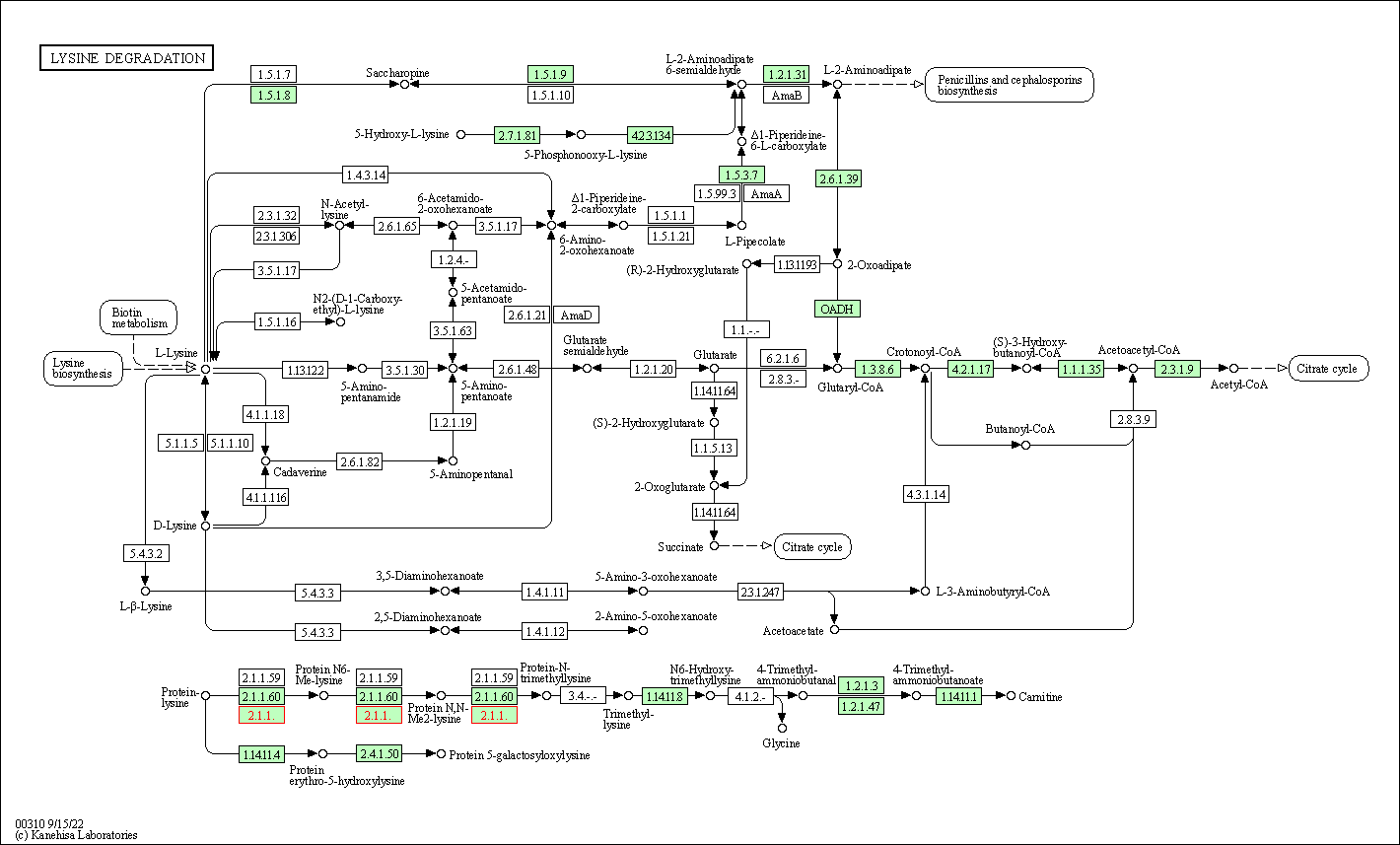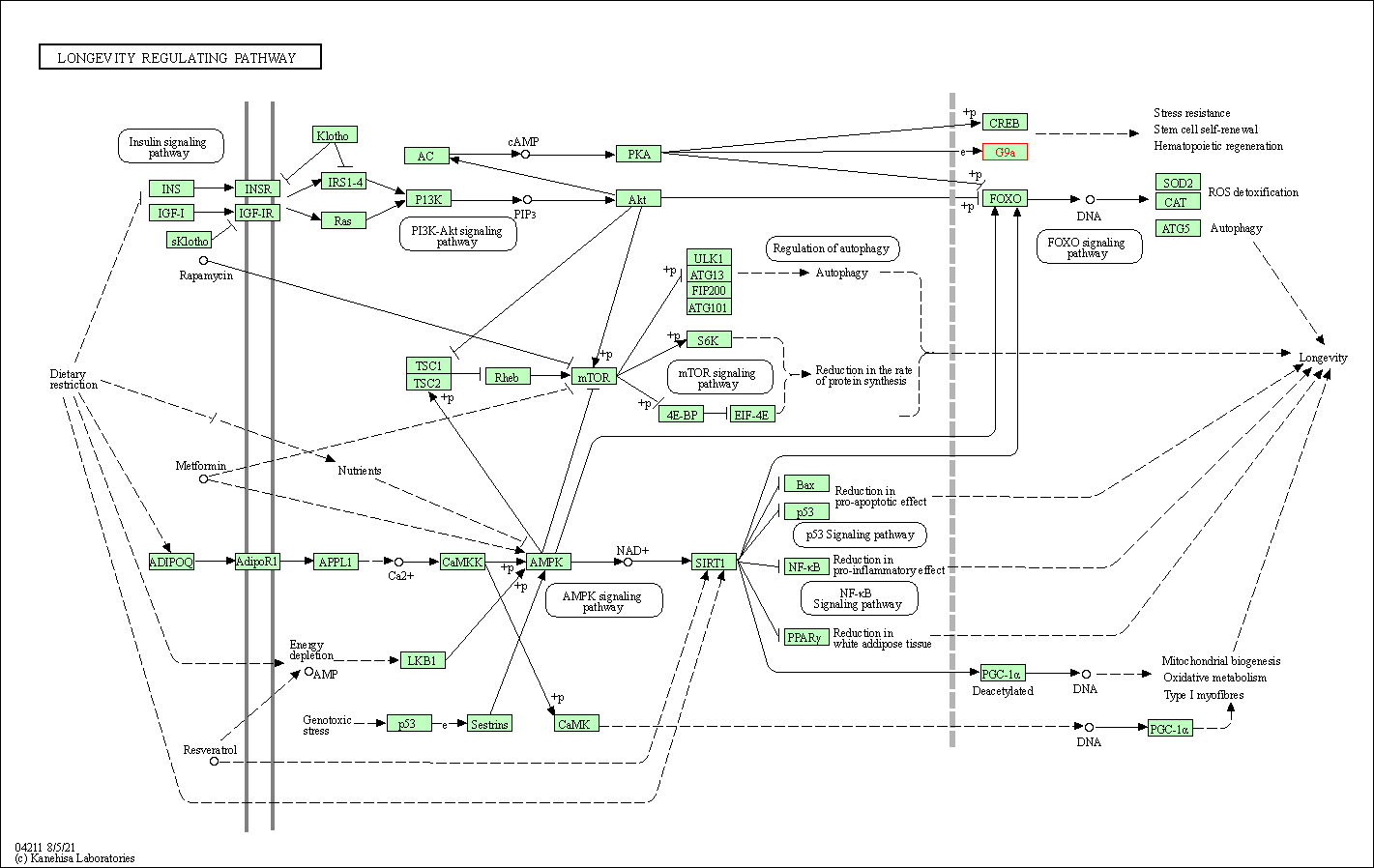Target Information
| Target General Information | Top | |||||
|---|---|---|---|---|---|---|
| Target ID |
T39996
(Former ID: TTDI03185)
|
|||||
| Target Name |
Euchromatic histone-lysine N-methyltransferase 1 (EHMT1)
|
|||||
| Synonyms |
EHMT1
Click to Show/Hide
|
|||||
| Gene Name |
EHMT1
|
|||||
| Target Type |
Literature-reported target
|
[1] | ||||
| Disease | [+] 2 Target-related Diseases | + | ||||
| 1 | Breast cancer [ICD-11: 2C60-2C6Y] | |||||
| 2 | Solid tumour/cancer [ICD-11: 2A00-2F9Z] | |||||
| Function |
Histone methyltransferase that specifically mono- and dimethylates 'Lys-9' of histone H3 (H3K9me1 and H3K9me2, respectively) in euchromatin. H3K9me represents a specific tag for epigenetic transcriptional repression by recruiting HP1 proteins to methylated histones. Also weakly methylates 'Lys-27' of histone H3 (H3K27me). Also required for DNA methylation, the histone methyltransferase activity is not required for DNA methylation, suggesting that these 2 activities function independently. Probably targeted to histone H3 by different DNA-binding proteins like E2F6, MGA, MAX and/or DP1. During G0 phase, it probably contributes to silencing of MYC- and E2F-responsive genes, suggesting a role in G0/G1 transition in cell cycle. In addition to the histone methyltransferase activity, also methylates non-histone proteins: mediates dimethylation of 'Lys-373' of p53/TP53.
Click to Show/Hide
|
|||||
| UniProt ID | ||||||
| EC Number |
EC 2.1.1.-
|
|||||
| Sequence |
MAAADAEAVPARGEPQQDCCVKTELLGEETPMAADEGSAEKQAGEAHMAADGETNGSCEN
SDASSHANAAKHTQDSARVNPQDGTNTLTRIAENGVSERDSEAAKQNHVTADDFVQTSVI GSNGYILNKPALQAQPLRTTSTLASSLPGHAAKTLPGGAGKGRTPSAFPQTPAAPPATLG EGSADTEDRKLPAPGADVKVHRARKTMPKSVVGLHAASKDPREVREARDHKEPKEEINKN ISDFGRQQLLPPFPSLHQSLPQNQCYMATTKSQTACLPFVLAAAVSRKKKRRMGTYSLVP KKKTKVLKQRTVIEMFKSITHSTVGSKGEKDLGASSLHVNGESLEMDSDEDDSEELEEDD GHGAEQAAAFPTEDSRTSKESMSEADRAQKMDGESEEEQESVDTGEEEEGGDESDLSSES SIKKKFLKRKGKTDSPWIKPARKRRRRSRKKPSGALGSESYKSSAGSAEQTAPGDSTGYM EVSLDSLDLRVKGILSSQAEGLANGPDVLETDGLQEVPLCSCRMETPKSREITTLANNQC MATESVDHELGRCTNSVVKYELMRPSNKAPLLVLCEDHRGRMVKHQCCPGCGYFCTAGNF MECQPESSISHRFHKDCASRVNNASYCPHCGEESSKAKEVTIAKADTTSTVTPVPGQEKG SALEGRADTTTGSAAGPPLSEDDKLQGAASHVPEGFDPTGPAGLGRPTPGLSQGPGKETL ESALIALDSEKPKKLRFHPKQLYFSARQGELQKVLLMLVDGIDPNFKMEHQNKRSPLHAA AEAGHVDICHMLVQAGANIDTCSEDQRTPLMEAAENNHLEAVKYLIKAGALVDPKDAEGS TCLHLAAKKGHYEVVQYLLSNGQMDVNCQDDGGWTPMIWATEYKHVDLVKLLLSKGSDIN IRDNEENICLHWAAFSGCVDIAEILLAAKCDLHAVNIHGDSPLHIAARENRYDCVVLFLS RDSDVTLKNKEGETPLQCASLNSQVWSALQMSKALQDSAPDRPSPVERIVSRDIARGYER IPIPCVNAVDSEPCPSNYKYVSQNCVTSPMNIDRNITHLQYCVCIDDCSSSNCMCGQLSM RCWYDKDGRLLPEFNMAEPPLIFECNHACSCWRNCRNRVVQNGLRARLQLYRTRDMGWGV RSLQDIPPGTFVCEYVGELISDSEADVREEDSYLFDLDNKDGEVYCIDARFYGNVSRFIN HHCEPNLVPVRVFMAHQDLRFPRIAFFSTRLIEAGEQLGFDYGERFWDIKGKLFSCRCGS PKCRHSSAALAQRQASAAQEAQEDGLPDTSSAAAADPL Click to Show/Hide
|
|||||
| 3D Structure | Click to Show 3D Structure of This Target | AlphaFold | ||||
| Drugs and Modes of Action | Top | |||||
|---|---|---|---|---|---|---|
| Preclinical Drug(s) | [+] 2 Preclinical Drugs | + | ||||
| 1 | A-366 | Drug Info | Preclinical | Solid tumour/cancer | [2] | |
| 2 | BIX-01294 | Drug Info | Preclinical | Breast cancer | [2] | |
| Mode of Action | [+] 1 Modes of Action | + | ||||
| Inhibitor | [+] 4 Inhibitor drugs | + | ||||
| 1 | A-366 | Drug Info | [3] | |||
| 2 | BIX-01294 | Drug Info | [4] | |||
| 3 | UNC0638 | Drug Info | [1] | |||
| 4 | UNC0642 | Drug Info | [5] | |||
| Cell-based Target Expression Variations | Top | |||||
|---|---|---|---|---|---|---|
| Cell-based Target Expression Variations | ||||||
| Drug Binding Sites of Target | Top | |||||
|---|---|---|---|---|---|---|
| Ligand Name: Ademetionine | Ligand Info | |||||
| Structure Description | Crystal structure of catalytic domain of GLP with MS012 | PDB:5TTG | ||||
| Method | X-ray diffraction | Resolution | 1.66 Å | Mutation | No | [6] |
| PDB Sequence |
VERIVSRDIA
1015 RGYERIPIPC1025 VNAVDSEPCP1035 SNYKYVSQNC1045 VTSPMNIDRN1055 ITHLQYCVCI 1065 DDCSSSNCMC1075 GQLSMRCWYD1085 KDGRLLPEFN1095 MAEPPLIFEC1105 NHACSCWRNC 1115 RNRVVQNGLR1125 ARLQLYRTRD1135 MGWGVRSLQD1145 IPPGTFVCEY1155 VGELISDSEA 1165 DVREEDSYLF1175 DLDNDGEVYC1186 IDARFYGNVS1196 RFINHHCEPN1206 LVPVRVFMAH 1216 QDLRFPRIAF1226 FSTRLIEAGE1236 QLGFDYGERF1246 WDIKGKLFSC1256 RCGSPKCRHS 1266
|
|||||
|
|
ARG1132
4.753
MET1136
2.699
GLY1137
3.696
TRP1138
2.805
SER1172
3.249
TYR1173
2.738
ARG1197
3.224
PHE1198
3.636
ILE1199
3.757
ASN1200
2.889
|
|||||
| Click to View More Binding Site Information of This Target and Ligand Pair | ||||||
| Ligand Name: MS012 | Ligand Info | |||||
| Structure Description | Crystal structure of catalytic domain of GLP with MS012 | PDB:5TTG | ||||
| Method | X-ray diffraction | Resolution | 1.66 Å | Mutation | No | [6] |
| PDB Sequence |
VERIVSRDIA
1015 RGYERIPIPC1025 VNAVDSEPCP1035 SNYKYVSQNC1045 VTSPMNIDRN1055 ITHLQYCVCI 1065 DDCSSSNCMC1075 GQLSMRCWYD1085 KDGRLLPEFN1095 MAEPPLIFEC1105 NHACSCWRNC 1115 RNRVVQNGLR1125 ARLQLYRTRD1135 MGWGVRSLQD1145 IPPGTFVCEY1155 VGELISDSEA 1165 DVREEDSYLF1175 DLDNDGEVYC1186 IDARFYGNVS1196 RFINHHCEPN1206 LVPVRVFMAH 1216 QDLRFPRIAF1226 FSTRLIEAGE1236 QLGFDYGERF1246 WDIKGKLFSC1256 RCGSPKCRHS 1266
|
|||||
|
|
||||||
| Click to View More Binding Site Information of This Target with Different Ligands | ||||||
| Different Human System Profiles of Target | Top |
|---|---|
|
Human Similarity Proteins
of target is determined by comparing the sequence similarity of all human proteins with the target based on BLAST. The similarity proteins for a target are defined as the proteins with E-value < 0.005 and outside the protein families of the target.
A target that has fewer human similarity proteins outside its family is commonly regarded to possess a greater capacity to avoid undesired interactions and thus increase the possibility of finding successful drugs
(Brief Bioinform, 21: 649-662, 2020).
Human Tissue Distribution
of target is determined from a proteomics study that quantified more than 12,000 genes across 32 normal human tissues. Tissue Specificity (TS) score was used to define the enrichment of target across tissues.
The distribution of targets among different tissues or organs need to be taken into consideration when assessing the target druggability, as it is generally accepted that the wider the target distribution, the greater the concern over potential adverse effects
(Nat Rev Drug Discov, 20: 64-81, 2021).
Human Pathway Affiliation
of target is determined by the life-essential pathways provided on KEGG database. The target-affiliated pathways were defined based on the following two criteria (a) the pathways of the studied target should be life-essential for both healthy individuals and patients, and (b) the studied target should occupy an upstream position in the pathways and therefore had the ability to regulate biological function.
Targets involved in a fewer pathways have greater likelihood to be successfully developed, while those associated with more human pathways increase the chance of undesirable interferences with other human processes
(Pharmacol Rev, 58: 259-279, 2006).
Biological Network Descriptors
of target is determined based on a human protein-protein interactions (PPI) network consisting of 9,309 proteins and 52,713 PPIs, which were with a high confidence score of ≥ 0.95 collected from STRING database.
The network properties of targets based on protein-protein interactions (PPIs) have been widely adopted for the assessment of target’s druggability. Proteins with high node degree tend to have a high impact on network function through multiple interactions, while proteins with high betweenness centrality are regarded to be central for communication in interaction networks and regulate the flow of signaling information
(Front Pharmacol, 9, 1245, 2018;
Curr Opin Struct Biol. 44:134-142, 2017).
Human Similarity Proteins
Human Tissue Distribution
Human Pathway Affiliation
Biological Network Descriptors
|
|
|
Note:
If a protein has TS (tissue specficity) scores at least in one tissue >= 2.5, this protein is called tissue-enriched (including tissue-enriched-but-not-specific and tissue-specific). In the plots, the vertical lines are at thresholds 2.5 and 4.
|
| KEGG Pathway | Pathway ID | Affiliated Target | Pathway Map |
|---|---|---|---|
| Lysine degradation | hsa00310 | Affiliated Target |

|
| Class: Metabolism => Amino acid metabolism | Pathway Hierarchy | ||
| Longevity regulating pathway | hsa04211 | Affiliated Target |

|
| Class: Organismal Systems => Aging | Pathway Hierarchy | ||
| Degree | 3 | Degree centrality | 3.22E-04 | Betweenness centrality | 8.52E-06 |
|---|---|---|---|---|---|
| Closeness centrality | 2.29E-01 | Radiality | 1.40E+01 | Clustering coefficient | 3.33E-01 |
| Neighborhood connectivity | 9.50E+01 | Topological coefficient | 3.43E-01 | Eccentricity | 12 |
| Download | Click to Download the Full PPI Network of This Target | ||||
| Chemical Structure based Activity Landscape of Target | Top |
|---|---|
| Drug Property Profile of Target | Top | |
|---|---|---|
| (1) Molecular Weight (mw) based Drug Clustering | (2) Octanol/Water Partition Coefficient (xlogp) based Drug Clustering | |
|
|
||
| (3) Hydrogen Bond Donor Count (hbonddonor) based Drug Clustering | (4) Hydrogen Bond Acceptor Count (hbondacc) based Drug Clustering | |
|
|
||
| (5) Rotatable Bond Count (rotbonds) based Drug Clustering | (6) Topological Polar Surface Area (polararea) based Drug Clustering | |
|
|
||
| "RO5" indicates the cutoff set by lipinski's rule of five; "D123AB" colored in GREEN denotes the no violation of any cutoff in lipinski's rule of five; "D123AB" colored in PURPLE refers to the violation of only one cutoff in lipinski's rule of five; "D123AB" colored in BLACK represents the violation of more than one cutoffs in lipinski's rule of five | ||
| Target Poor or Non Binders | Top | |||||
|---|---|---|---|---|---|---|
| Target Poor or Non Binders | ||||||
| Target Regulators | Top | |||||
|---|---|---|---|---|---|---|
| Target-interacting Proteins | ||||||
| References | Top | |||||
|---|---|---|---|---|---|---|
| REF 1 | A chemical probe selectively inhibits G9a and GLP methyltransferase activity in cells. Nat Chem Biol. 2011 Jul 10;7(8):566-74. | |||||
| REF 2 | Epigenetics and beyond: targeting writers of protein lysine methylation to treat disease. Nat Rev Drug Discov. 2021 Apr;20(4):265-286. | |||||
| REF 3 | Discovery and development of potent and selective inhibitors of histone methyltransferase g9a. ACS Med Chem Lett. 2014 Jan 2;5(2):205-9. | |||||
| REF 4 | Reversal of H3K9me2 by a small-molecule inhibitor for the G9a histone methyltransferase. Mol Cell. 2007 Feb 9;25(3):473-81. | |||||
| REF 5 | Discovery of an in vivo chemical probe of the lysine methyltransferases G9a and GLP. J Med Chem. 2013 Nov 14;56(21):8931-42. | |||||
| REF 6 | Discovery of Potent and Selective Inhibitors for G9a-Like Protein (GLP) Lysine Methyltransferase. J Med Chem. 2017 Mar 9;60(5):1876-1891. | |||||
If You Find Any Error in Data or Bug in Web Service, Please Kindly Report It to Dr. Zhou and Dr. Zhang.

